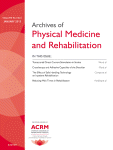
Physical Therapy & Rehab
Cross-education training improves strength and ROM after unilateral distal radius fracture
This report has been verified
by one or more authors of the
original publication.
Arch Phys Med Rehabil. 2013 Jul;94(7):1247-55. doi: 10.1016/j.apmr.2013.03.005. Epub 2013 Mar 22
Fifty-one women, older than 50 years of age, with a unilateral distal radius fracture were randomized to standard rehabilitation or standard rehabilitation plus cross education strength training to compare training effects on strength and mobility of the fractured limb. Cross-education is a term for neural adaptation defined by increased strength or functional performance of the affected limb after unilateral training of the contralateral unaffected limb. The fractured hand demonstrated significantly better hand grip peak force strength and range of motion at wrist flexion/extension than the control at 12 weeks. No differences were seen by 26 weeks in peak force strength, ROM (flexion/extension; supination/pronation) or in Patient Rated Wrist Evaluation questionnaires.
Unlock the full article
Get unlimited access to OrthoEvidence with a free trial
Start TrialCritical appraisals of the latest, high-impact randomized controlled trials and systematic reviews in orthopaedics
Access to OrthoEvidence podcast content, including collaborations with the Journal of Bone and Joint Surgery, interviews with internationally recognized surgeons, and roundtable discussions on orthopaedic news and topics
Subscription to The Pulse, a twice-weekly evidence-based newsletter designed to help you make better clinical decisions
Exclusive access to original content articles, including in-house systematic reviews, and articles on health research methods and hot orthopaedic topics
Or continue reading this full article
Register Now

Subscribe to "The Pulse"
Evidence-Based Orthopaedics direct to your inbox.





































